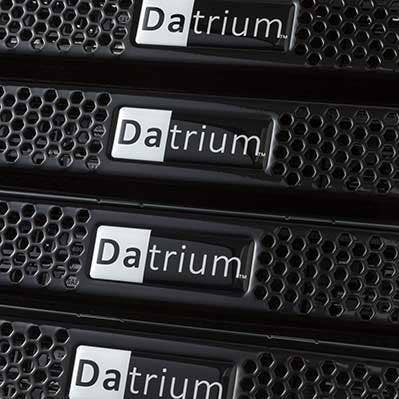Datrium Automatrix Brings Software-Defined Converged Infrastructure To Multi-Cloud Environments
The first application for Automatrix, ControlShift, allows partners to manage and orchestrate compute, primary, backup, disaster recovery and data mobility across on-premises and multiple clouds.

Multi-cloud data platform software developer Datrium is now shipping its Automatrix platform for providing compute, primary storage, backup, disaster recovery, encryption and data mobility from a single offering.
With the introduction of Automatrix, Datrium has completed its vision of providing those capabilities in an integrated fashion, said Tim Page, CEO of the Sunnyvale, Calif.-based company.
"We are a multi-cloud platform, and we've done the hard things that no one else has done," Page told CRN.
[Related: The 20 Coolest Cloud Storage Vendors Of The 2019 Cloud 100]
Datrium develops the DVX series of on-premises hyper-converged infrastructure offerings with separate server and storage nodes targeted. DVX provides a flash storage platform for running customer applications and includes built-in data protection and disaster recovery capabilities.
The company also develops Cloud DVX, a cloud-native version of DVX for Software-as-a-Service-based backup and recovery, and ControlShift, a new automated disaster recovery offering with fast recovery, global deduplication, continuous compliance checks, and nondisruptive disaster recovery testing.
Automatrix brings together compute, primary storage, backup storage, disaster recovery, encryption and data mobility in a single software-defined converged infrastructure, along with a suite of autonomous data management applications including ControlShift.
Datrium has been developing its platform for automated data management of data in the cloud and now has a true enterprise-class offering, Page said.
"We have a hardened platform that can be deployed in a hyper-converged infrastructure fashion, or can go after the big guys," he said. "We're going after the big guys."
The first Automatrix application is ControlShift, which brings the company's on-premises DVX offering to private and public clouds, said Tushar Agrawal, director of product management and marketing for Datrium.
"ControlShift provides data orchestration, and offers blockchain and push-button simplicity for disaster recovery," Agrawal told CRN. "Customers don't have to deploy, manage, or upgrade anything. Just log in, create orchestration plans, and click 'go.' They can architect data recovery from a DVX or a public cloud."
ControlShift provides converged recovery of primary, backup, and disaster recovery data with the ability to recovery from the latest or from very old snapshots, Agrawal said. It offers efficient replication by only sending duplicated data, giving customers a recovery point objective of only five minutes, he said.
Customers can use it for continuous compliance tests to provide what Agrawal called an "RCO," or recover compliance objective.
Customers pay for ControlShift as needed, Agrawal said.
"It's a true pay-per-use cloud disaster recovery offering," he said. "It has a data plane, a virtualization plane,and a management plane consistent from DVX to the cloud. Customers can get it licensed as a complete SaaS offering or can deploy it in their own cloud, all with the same experience and nothing to manage or deploy."
ControlShift is licensed on a per-virtual-machine basis, with a cost as low as $320 per virtual machine including five years of service, Agrawal said.
"Channel partners can add disaster recovery planning around this," he said. "They can also host infrastructure on-premises and offer it as an MSP to multiple customers. Partners can also leverage Datrium's own cloud offering, or leverage VMware on AWS to get cloud revenue."
Datrium has a cool story to tell, said Rocco Guerriero, CEO of Contour Data Solutions, a Doylestown, Pa.-based cloud service provider that has worked with the vendor for about one and a half years.
"They're different," told CRN. "I like different. They have a unique approach to data management. They were doing a lot of cool things with security and disaster recovery before they even knew how to describe it."
Contour Data Solutions has a platform called Contour Cinch built on Datrium's Automatrix platform and helped write the Automatrix APIs, Guerriero said.
ControlShift is a big piece of Contour Cinch, Guerriero said.
"Disaster recovery needs full orchestration to move data and make sure the infrastructure is configured properly and so on," he said. "Other vendors can do disaster recovery. What ControlShift brings is the ability to do a hybrid cloud from a DR perspective. Customers can have an application at Point A, and move it to Point B without having to do all the functions separately. ControlShift allows data to be moved intelligently across all cloud platforms so I can move my customer workloads to a hybrid environment leveraging our private cloud, Azure, AWS, and so on. This allows us to be open. Nobody wants proprietary."
Datrium has had difficulty explaining how it has converged five different functionalities into a single platform, but that is changing with the release of Automatrix, said Phil Abeyta, president of Ardham Technologies, an Albuquerque, N.M.-based solution provider and MSP that started working with the vendor in 2017.
"We have a tremendous passion for instant outcomes for our clients," Abeyta told CRN. "Automatrix will be a major player for our customers. The software is a service framework for using data across multiple clouds."
Looking forward, Datrium is expecting to launch disaster recovery for non-DVX hosts and to provide failover to the VMware Cloud on AWS platform in the fourth quarter of 2019, Agrawal said.
Datrium also plans to allow customers to run DVX on the AWS cloud as primary storage in the fourth quarter of this year, and to port its technology to Microsoft Azure some time next year, Page said. The company will also move to the Google Cloud Platform when its customers do, he said.
"As customers want to get off existing storage arrays, we make it possible using DVX," he said. "We let customers move data off existing storage, and remove the legacy technology off their floor as it comes off lease, and offer them DVX as a replacement because of its lower cost."